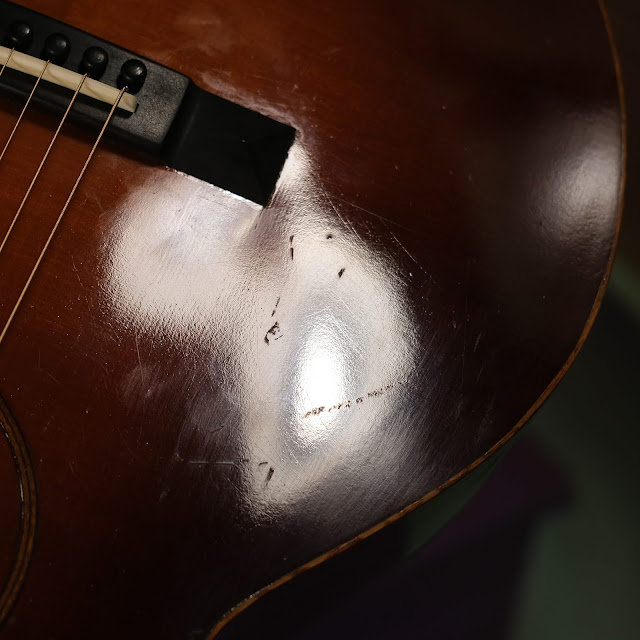2010s/2020 James Einolf (Gibson L-1 Copy) Parlor Guitar
Update 2021: this has been on laying-about shakedown here since around December and I've finally made a new saddle for it and set it up again. I've updated the blog post with new pics, a new video, and information as needed.
So, I worked-on and sold another Einolf some years back. My friend Ed of our local jam group still owns that guitar and uses it as a daily player. A customer/consignor of mine sent this Einolf to me as a curious project. It was a "workshop-unused" instrument and arrived as a finished body and neck, but not put-together and without a bridge, tuners, nut, saddle, pins, and whatnot.
I put it together, and after getting it all good to go I have to say that I'm pleased with the sound. It's full, clean, absolutely adores fingerpicking, and rings nicely. It's close to the vibe of an x-braced L-1 from the late '20s, but the maple back and sides (compared to mahogany) give it a distinctly-different tone -- more immediate and with a bit more clarity than "normal." The neck is also a fair bit bigger than period L-0/L-1 models and reminds me more of '20s archtop versions of the L-series.
Because these were clearly parts that were hanging-around a workshop for a while, the finish shows wear and tear, some improper curing throughout, and other blem. It basically... looks like it might've been hanging-out and getting played at gigs for the last decade, though perhaps it's a little "fresher" than that. There's a little glue-blem along the binding edges as well.
Repairs included: fitting the neck to the body (it's a bolted joint with 3 bolts), a fret level/dress, new bone nut, tuner install (StewMac relic'd style), new ebony pyramid bridge, bridge pins, and new bone saddle.
Setup notes: action is spot-on at 3/32" EA and 1/16" DGBE height at the 12th fret. Strings are 46w-10 in gauge (these Einolf guitars are built quite light and so I never suggest 54w-12 on them), the neck is straight, and the truss rod works. There's a ton of saddle left to adjust to taste as need be.
Made by: James Einolf
Made in: Colorado, USA
Serial number: 60
Top wood: solid spruce
Back & sides wood: solid maple
Bracing type: x
Bridge: ebony
Fretboard: ebony
Neck wood: mahogany
Action height at 12th fret: 3/32” bass 1/16” treble (fast, spot-on)
String gauges: 46w-10 extra lights
Neck shape: bigger C/V ridge
Board radius: ~10-12"
Truss rod: adjustable
Neck relief: straight
Fret style: medium
Scale length: 24 3/8"
Nut width: 1 5/8"
Body length: 18 3/4"
Body width: 13 3/4"
Body depth: 4"
Weight: 3 lbs 10 oz
Condition notes: as noted, the finish has blem throughout but looks decent at a glance. See high-glare pics to get an idea. The bridge, nut, saddle, pins, and tuners are unoriginal to the design. There's a repaired small hairline crack (done at the Einolf workshop, I assume) on the back, upper-bout that's pictured. There are two smaller finish hairlines on the upper-bout-back that do not appear to be cracks but follow the grain.
The truss rod access is buried at the neck pocket (like on Froggy Bottoms, no less!), so that can be irritating to adjust as you have to detune the strings -- but fortunately it won't need it very often. I've only adjusted my friend Ed's rod... once? ...since he's had it.
The fretboard extension is shimmed-up with an undersized shim under it. This is just my preference but it looks more old-fashioned than modern guitars. The neck angle is pretty steep so the saddle's a little extra-tall at the moment. I actually aimed for 1/16" or so lower but the guitar settled this way after glue-up and shakedown. I assume in summer it will swell-up a bit and the saddle will need to be shaved/lowered a little.
The neck joint itself is a dovetail joint but it was sloppily-cut so it's both shimmed-up and glued and bolted at the neck block with three bolts. I like security -- and they're hidden.


























Comments